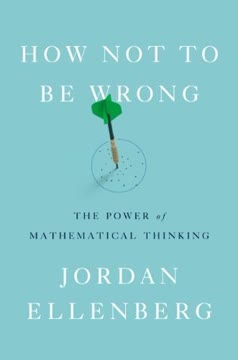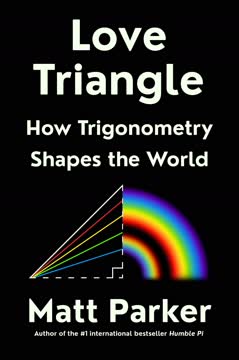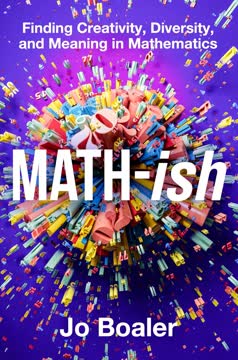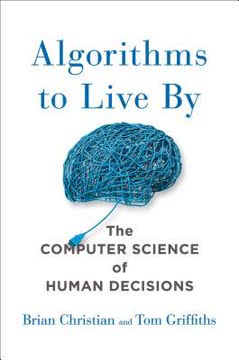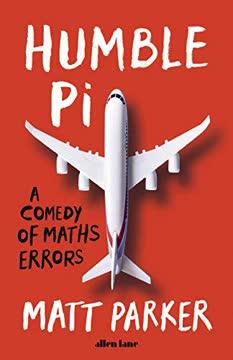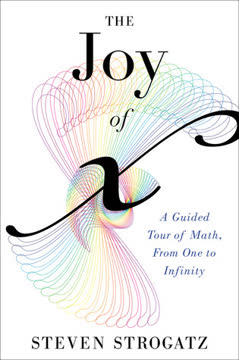Puntos clave
1. Matemáticas: El Lenguaje de Patrones y Relaciones
Los números son atajos maravillosos.
El código de la naturaleza. Las matemáticas son el lenguaje universal que describe patrones y relaciones en el mundo que nos rodea. No se trata solo de aritmética o de resolver ecuaciones, sino de una forma de pensar que nos permite entender y predecir fenómenos naturales. Desde las espirales de un girasol hasta las órbitas de los planetas, las matemáticas proporcionan un marco para describir el orden subyacente en sistemas que parecen caóticos.
Abstracción y aplicación. El poder de las matemáticas radica en su capacidad para abstraer situaciones complejas del mundo real en modelos más simples y manejables. Esta abstracción nos permite resolver problemas en un dominio y aplicar esas soluciones a campos completamente diferentes. Por ejemplo, los mismos principios matemáticos utilizados para describir el flujo del agua pueden aplicarse para entender patrones de tráfico o la propagación de enfermedades.
Conceptos matemáticos clave:
- Patrones y relaciones
- Abstracción y modelado
- Aplicabilidad universal
2. De Contar a la Infinidad: La Evolución de los Números
Los números primos son divisibles solo por 1 y por sí mismos.
Expansión de los sistemas numéricos. El concepto de números ha evolucionado drásticamente a lo largo de la historia, desde el conteo simple hasta los complejos sistemas numéricos que utilizamos hoy. Esta evolución refleja nuestra creciente comprensión del mundo y nuestra necesidad de describir conceptos cada vez más abstractos.
Lo infinito y lo infinitesimal. Uno de los desarrollos más profundos en matemáticas fue la incorporación de la infinitud y los infinitesimales. Estos conceptos, alguna vez considerados paradójicos, son ahora fundamentales para el cálculo y nuestra comprensión de los procesos continuos. La capacidad de trabajar con lo infinito ha permitido a los matemáticos resolver problemas que antes se creían imposibles.
Evolución de los sistemas numéricos:
- Números naturales (conteo)
- Números enteros (incluyendo números negativos)
- Números racionales (fracciones)
- Números irracionales (p. ej., π, √2)
- Números reales
- Números complejos
3. Álgebra: Resolviendo para X y Trabajando con Fórmulas
Una página es buena en la medida en que páginas buenas se vinculan a ella.
El lenguaje de las relaciones. El álgebra proporciona un conjunto de herramientas poderosas para describir relaciones entre cantidades. Al utilizar variables y ecuaciones, podemos expresar ideas complejas de manera concisa y manipulable. Esta abstracción nos permite resolver problemas que serían intratables utilizando solo la aritmética.
De lo antiguo a lo moderno. El pensamiento algebraico ha evolucionado desde la resolución de problemas simples hasta ser la base de las tecnologías modernas. Los mismos principios que permitieron a los matemáticos antiguos calcular herencias ahora forman la base de algoritmos que impulsan motores de búsqueda y sistemas de recomendación.
Conceptos algebraicos clave:
- Variables y ecuaciones
- Funciones y relaciones
- Resolviendo incógnitas
- Modelando problemas del mundo real
4. Geometría: Lógica, Intuición y la Naturaleza del Espacio
La topología pone de relieve las propiedades más profundas de una forma: las propiedades que permanecen inalteradas tras una deformación continua.
Uniendo intuición y lógica. La geometría ofrece una combinación única de intuición visual y lógica rigurosa. Nos permite razonar sobre el espacio y la forma de maneras que son tanto intelectualmente satisfactorias como prácticamente útiles. Desde el teorema de Pitágoras hasta las geometrías no euclidianas, el pensamiento geométrico ha influido profundamente en nuestra comprensión del mundo físico.
Más allá de la planicie. La geometría moderna se extiende mucho más allá del estudio de las formas en un plano. La topología, por ejemplo, explora propiedades que permanecen inalteradas bajo deformaciones continuas, lo que lleva a conocimientos en campos tan diversos como el análisis de datos y la física teórica.
Conceptos y aplicaciones geométricas:
- Geometría euclidiana: líneas, ángulos, formas
- Geometrías no euclidianas: espacios curvados
- Topología: propiedades invariantes bajo deformación
- Aplicaciones: arquitectura, gráficos por computadora, cosmología
5. Cálculo: Las Matemáticas del Cambio y el Movimiento
El cálculo es la matemática del cambio.
El lenguaje de la física. El cálculo proporciona el marco matemático para describir el cambio y el movimiento. Nos permite analizar y predecir sistemas dinámicos, desde la órbita de los planetas hasta la propagación de epidemias. Los conceptos fundamentales de derivadas e integrales ofrecen herramientas poderosas para entender las tasas de cambio y la acumulación.
La infinitud domesticada. En su esencia, el cálculo trata con procesos que involucran cantidades infinitamente pequeñas o sumas infinitas. Al desarrollar métodos rigurosos para trabajar con estos conceptos, los matemáticos pudieron resolver problemas que habían desconcertado a los pensadores durante siglos. Este "domesticado" de la infinitud ha tenido profundas implicaciones en la ciencia y la ingeniería.
Conceptos clave del cálculo:
- Derivadas: tasas de cambio
- Integrales: acumulación y área
- Límites: lidiando con la infinitud
- Aplicaciones: física, economía, optimización
6. Probabilidad y Estadística: Dando Sentido a la Aleatoriedad
Las cosas que parecen desesperadamente aleatorias e impredecibles cuando se ven de forma aislada a menudo resultan ser legales y predecibles cuando se ven en conjunto.
Cuantificando la incertidumbre. La probabilidad y la estadística proporcionan herramientas para entender y tomar decisiones frente a la incertidumbre. Estos campos nos permiten analizar datos, probar hipótesis y hacer predicciones sobre sistemas complejos donde los resultados individuales pueden ser impredecibles.
Del juego a los grandes datos. Originalmente desarrolladas para entender juegos de azar, la probabilidad y la estadística ahora juegan roles cruciales en campos que van desde la investigación científica hasta la analítica empresarial. La capacidad de extraer patrones significativos de grandes conjuntos de datos se ha vuelto cada vez más importante en nuestro mundo impulsado por datos.
Conceptos clave en probabilidad y estadística:
- Distribuciones de probabilidad
- Inferencia estadística
- Pruebas de hipótesis
- Análisis y visualización de datos
7. El Poder del Pensamiento Matemático en el Mundo Real
Las matemáticas son la herramienta más poderosa que la humanidad ha creado jamás para dar sentido al mundo material.
Mentalidad de resolución de problemas. El pensamiento matemático se extiende mucho más allá de resolver ecuaciones. Proporciona un enfoque estructurado para la resolución de problemas que puede aplicarse en muchas áreas de la vida. Al descomponer problemas complejos en componentes más simples, identificar patrones y razonar lógicamente, podemos abordar los desafíos de manera más efectiva.
Impacto interdisciplinario. El poder de las matemáticas radica en su capacidad para describir patrones fundamentales que aparecen en diversos campos. Desde la optimización de cadenas de suministro hasta la comprensión de redes sociales, los modelos matemáticos proporcionan conocimientos que impulsan la innovación y la toma de decisiones en negocios, tecnología y políticas.
Aplicaciones del mundo real de las matemáticas:
- Finanzas y economía
- Ciencias de la computación e inteligencia artificial
- Ingeniería y tecnología
- Ciencias sociales y formulación de políticas
- Medicina y atención sanitaria
- Ciencia ambiental y modelado climático
Última actualización:
FAQ
What's "The Joy of X" by Steven H. Strogatz about?
- Guided tour of math: The book is a guided tour through the elements of mathematics, from basic arithmetic to advanced concepts like calculus and complex numbers.
- Math's beauty and utility: It aims to show the beauty and utility of math, explaining why it is so enthralling to those who understand it.
- Real-world applications: The book connects mathematical concepts to real-world scenarios, such as Michael Jordan's dunks explaining calculus fundamentals.
- Accessible to all: It is designed for anyone who wants a second chance at understanding math, from an adult perspective.
Why should I read "The Joy of X"?
- Rekindle interest in math: It offers a chance to rediscover math in a more engaging and less intimidating way than traditional education.
- Understand math's relevance: The book demonstrates how math is relevant in everyday life, from flipping mattresses to understanding stock market swings.
- Enjoyable learning experience: Strogatz uses humor and storytelling to make complex mathematical ideas accessible and enjoyable.
- Broaden your perspective: It provides insights into how math shapes our understanding of the world, from the smallest particles to the vastness of the universe.
What are the key takeaways of "The Joy of X"?
- Math is everywhere: Math is present in various aspects of life, from nature to technology, and understanding it can enhance our perception of the world.
- Conceptual understanding: The book emphasizes understanding mathematical concepts rather than just memorizing formulas.
- Interconnectedness of math: It shows how different areas of math, like algebra and geometry, are interconnected and build upon each other.
- Math's creative side: Strogatz highlights the creativity involved in solving mathematical problems and constructing proofs.
How does Steven H. Strogatz explain complex numbers in "The Joy of X"?
- Imaginary numbers introduction: Complex numbers are introduced through the concept of imaginary numbers, defined by the square root of -1, denoted as 'i'.
- Visual representation: Strogatz explains complex numbers using a two-dimensional plane, with real numbers on one axis and imaginary numbers on the other.
- Applications in engineering: The book discusses how complex numbers are used in engineering fields, such as electrical engineering, to simplify calculations involving rotations.
- Fundamental theorem of algebra: Complex numbers are shown to be the culmination of the number system, as they allow for the solution of all polynomial equations.
What is the significance of the Pythagorean theorem in "The Joy of X"?
- Foundation of geometry: The Pythagorean theorem is presented as a fundamental concept in geometry, relating the sides of a right triangle.
- Proofs and elegance: Strogatz provides multiple proofs of the theorem, highlighting the elegance and creativity involved in mathematical reasoning.
- Real-world applications: The theorem's applications are discussed, such as in surveying and construction, where it helps calculate distances.
- Insight into space: It reveals fundamental truths about the nature of space, indicating that space is flat in Euclidean geometry.
How does "The Joy of X" approach the concept of infinity?
- Infinity in calculus: Infinity is explored through its role in calculus, particularly in understanding limits, derivatives, and integrals.
- Paradoxes and challenges: The book discusses historical challenges and paradoxes associated with infinity, such as Zeno's paradoxes.
- Archimedes' method: Strogatz explains how Archimedes used the concept of infinity to approximate pi through the method of exhaustion.
- Infinity's impact: The book illustrates how embracing infinity has led to significant advancements in mathematics and science.
What are some of the best quotes from "The Joy of X" and what do they mean?
- "Math is everywhere, if you know where to look." This quote emphasizes the omnipresence of mathematics in daily life and the importance of recognizing its applications.
- "The right abstraction leads to new insight, and new power." It highlights the power of abstraction in mathematics to simplify complex problems and reveal deeper truths.
- "Math always involves both invention and discovery." This quote reflects the dual nature of mathematics as both a creative and exploratory discipline.
- "The domestication of infinity was the breakthrough that made calculus work." It underscores the pivotal role of infinity in the development of calculus and its applications.
How does "The Joy of X" explain the concept of derivatives?
- Rate of change: Derivatives are introduced as a measure of how fast something is changing, akin to the slope of a curve.
- Real-world examples: Strogatz uses examples like the slope of a ramp and Michael Jordan's jump to illustrate the concept of derivatives.
- Applications in optimization: The book discusses how derivatives are used to find maximum and minimum values in various contexts, such as optimizing travel paths.
- Connection to calculus: Derivatives are presented as one of the two central ideas in calculus, alongside integrals.
What is the role of integrals in "The Joy of X"?
- Summation of parts: Integrals are explained as a way to sum up small parts to find a whole, such as calculating areas under curves.
- Applications in physics: The book discusses how integrals are used in physics to calculate quantities like gravitational pull and tumor growth.
- Fundamental theorem of calculus: Strogatz highlights the connection between derivatives and integrals through the fundamental theorem of calculus.
- Real-world relevance: Integrals are shown to be crucial in understanding and predicting changes in various scientific and engineering fields.
How does "The Joy of X" address the concept of probability?
- Conditional probability: The book explains conditional probability and its importance in understanding events given certain conditions.
- Real-life scenarios: Strogatz uses examples like plant watering and medical tests to illustrate how conditional probability works.
- Misconceptions and clarity: The book addresses common misconceptions about probability and offers clearer ways to think about it using natural frequencies.
- Applications in decision-making: Probability is shown to be a valuable tool in making informed decisions in uncertain situations.
What insights does "The Joy of X" provide on the use of logarithms?
- Compressing information: Logarithms are explained as tools for compressing large ranges of numbers into more manageable scales.
- Applications in music and science: The book discusses how logarithms are used in music perception and scientific measurements like the Richter scale.
- Inverse of exponentials: Logarithms are presented as the inverse of exponential functions, crucial for solving equations involving growth and decay.
- Simplifying calculations: Strogatz highlights how logarithms simplify complex calculations, making them essential in various fields.
How does "The Joy of X" explore the concept of symmetry through group theory?
- Symmetry in transformations: Group theory is introduced as the study of transformations that leave certain properties unchanged, such as symmetry.
- Applications in art and science: The book discusses how group theory applies to areas like art, physics, and even mattress flipping.
- Understanding structure: Group theory is shown to reveal the underlying structure and relationships within mathematical systems.
- Versatility of group theory: Strogatz emphasizes the wide-ranging applications of group theory, from particle physics to everyday problems.
Reseñas
La Alegría de X recibe en su mayoría críticas positivas por hacer que las matemáticas sean accesibles y atractivas. Los lectores elogian las explicaciones claras de Strogatz, los ejemplos del mundo real y su capacidad para despertar el interés en las matemáticas. Muchos lo encuentran ameno y perspicaz, valorando el contexto histórico y las conexiones con la vida cotidiana. Algunos reseñadores señalan que ciertas secciones se vuelven más desafiantes, lo que podría hacer que algunos lectores, especialmente aquellos sin una sólida formación matemática, se sientan perdidos. En general, se recomienda el libro a quienes buscan redescubrir la belleza y la relevancia de las matemáticas, aunque las opiniones varían sobre su efectividad para los completos novatos en la materia.
Similar Books

